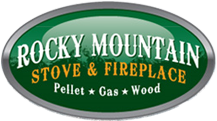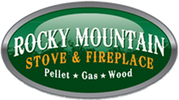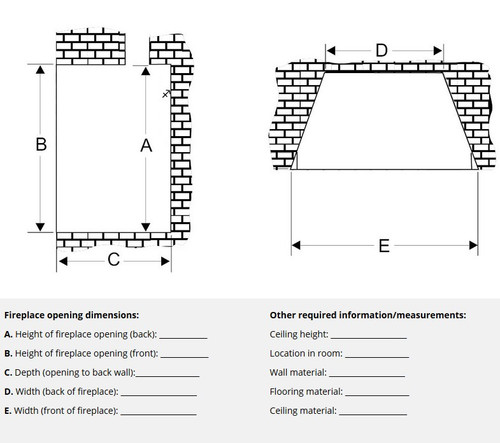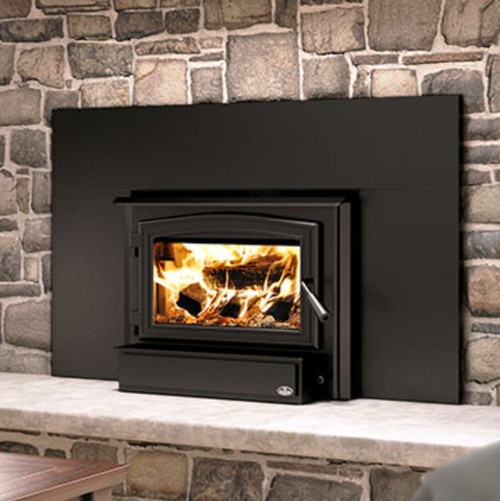Product Description
Everything You Need To Know About Purchasing a Wood Burning Fireplace Insert
Designed to fit into your existing masonry fireplace, It’s easy and affordable to upgrade your fireplace with a modern wood burning fireplace insert. Installing a wood insert is a quick and affordable way to update the look of a room, add value to your home and lower your monthly home heating bill. Wood burning fireplace inserts are installed into open masonry fireplaces to stop cold chimney draft, increase home heating efficiency and improve indoor air quality
How to get started
3. Free in-home estimate and installation with a licensed hearth professional: We are partnered with Denver's leading service and installation specialist that has specializes in gas and wood burning fireplace installation, service and repair since 1998, Fireplace and Grill Experts has been providing the Colorado Front Range with exceptional customer service and professional work on fireplaces, chimneys, grills, fire pits and gas lines.
FAQ - Wood Burning Fireplace Inserts
Types of Wood Burning Insert: Non-Catalytic Stoves
Two main types technology within wood stoves are Non-Catalytic “2-Stage Burn” and Catalytic.
On a non-catalytic stove, the airflow in the firebox is directed in such a way that fuel is burned in 2 stages: once during the initial combustion, and again when smoke is re-burned. This 2-stage burn creates greater efficiency and a spectacular fire to look at, as well as resulting in cleaner emissions. A downside to the non-catalytic route, however, is that it’s unable to achieve the same high levels of efficiency and low levels of emissions as its catalytic counterpart – but they are still EPA certified.
Types of Wood Stoves: Catalytic
In a catalytic stove a Catalytic combustor burns remaining un-burned gases, they are fed through a catalytic combustor chamber. This system delivers a balance of higher efficiency, cleaner combustion and maximum heat control – with less wood, less loading and less effort. However, one drawback to a catalytic stove is the additional step during the combustion process – opening and closing the bypass damper at the correct times. With proper wood burning practices the catalytic combustor can last up to 7-10 years and are easy to replace.
Types of Wood Stoves: Catalytic Hybrid
In a catalytic Hybrid stove an additional stage to burning is added; in stage 3 the remaining un-burned gases are fed through a catalytic combustor chamber. Boosting temperatures to over an astonishing 1,000 degrees Fahrenheit, the system delivers a balance of higher efficiency, cleaner combustion and maximum heat control – with less wood, less loading and less effort. However, one drawback to a catalytic stove is the additional step during the combustion process – opening and closing the bypass damper at the correct times. With proper wood burning practices the catalytic combustor can last up to 7-10 years and are easy to replace.
Can I add a fan to my wood burning Insert?
Yes Most wood insert either come with a blower or it is a recommend option you can add now or in the future.
Do I need to reline my chimney?
Yes, Having peace of mind, knowing your family, house and belongings are better protected from dangerous carbon monoxide and potential chimney fires, by the installation of a stainless flue liner. Whether it is a furnace, hot water heater, wood-burning insert or stove. by adding insulation you have also increased the protection, and added extra to the value of your home.
Now days when homes are sold many new buyers and realtors are asking for chimney inspections, and if you do not have a liner, they will ask to have one installed before purchasing
Does my liner need to be insulated?
NO, It is always a good idea to insulate your flexible chimney liner, but it is not always a requirement. The insulation will enable the flue to heat up more quickly and this increases your draft, reduces creosote, making it easier to clean and makes your system more efficient & safer. Having 1/2" thick insulation will maintain your liner to the UL1777 standard.
Could my wood insert be converted to gas burning in the future?
NO, Don’t do it. It is extremely dangerous, it is also illegal.
I’ve heard the term “Negative Air Pressure”. What is it?
Negative air pressure occurs when the air pressure inside a home, generally in the lowest level, is less than the barometric air pressure outside the house. As hot air naturally rises in a home, positive air pressure is created in upper levels of the home and negative air pressure in the lower levels. This phenomenon is created by modern construction techniques that restrict the amount of air that infiltrates a home.
In a worst-case scenario, negative air pressure can actually over power the draft in a chimney and draw make-up air down the chimney. Combustion appliances, exhaust fans, range hoods, bathroom fans, central vacuum units and clothes dryers can also pull air from inside the home, contributing to negative air pressure when they operate.


















